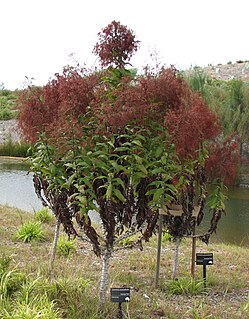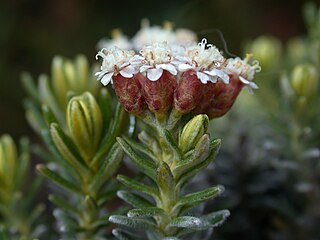
Hakea salicifolia commonly known as the willow-leaved hakea, is species of flowering plant that is endemic to eastern Australia. It is an adaptable, fast growing small tree or shrub with attractive foliage and cream white flowers.

Kennedia is a genus of thirteen species of flowering plants in the in the pea family Fabaceae and is endemic to Australia. Plants in this genus are prostrate or climbing perennials with trifoliate leaves and large, showy, pea-like flowers. There are species in all Australian states.

Hibiscus heterophyllus, commonly known as native rosella or toilet paper bush, is a flowering plant in the family Malvaceae. It a shrub or small tree with white, pale pink or yellow flowers with a dark red centre and grows in New South Wales and Queensland.

Aotus ericoides, also known as common aotus or golden pea, is a shrub in the family Fabaceae. It flowers in leaf axils in spring and has yellow pea flowers with splotches of red. It is endemic to eastern Australia.

Calomeria is a plant genus in the family Asteraceae.

Étienne Pierre Ventenat was a French botanist born in Limoges. He was the brother of naturalist Louis Ventenat (1765–1794).

Angophora floribunda, commonly known as the rough-barked apple, is a common woodland and forest tree of the family Myrtaceae native to Eastern Australia. Reaching 30 m (100 ft) high, it is a large tree with fibrous bark and cream-white flowers that appear over the Austral summer. It grows on alluvial soils on floodplains and along watercourses. Much of the land it grew on has been cleared for agriculture.

Kennedia rubicunda, commonly known as the dusky coral pea, is a species of flowering plant in the family Fabaceae and is endemic to eastern continental Australia. It is a twining or prostrate herb with trifoliate leaves and dark red or purple flowers.

Felicia filifolia is a Southern African member of the family Asteraceae. It is a hardy, sprawling shrub growing to about 1 metre tall. Leaves are narrow and clustered along the twigs. When blooming it is densely covered in flowerheads with ray florets that are pink-mauve to white and disc florets that are yellow. In the wild, flowers can be found August to December.

Ozothamnus ferrugineus, commonly known as tree everlasting, is a member of the genus Ozothamnus, of the Asteraceae family - one of the largest families of flowering plants in Australia. Native to the Australian states of New South Wales, Victoria, South Australia, and Tasmania, it forms an erect shrub or small tree between 2 and 3 metres in height.

Elaeodendron australe, commonly known as red olive-berry, red-fruited olive plum, or blush boxwood, is a species of flowering plant in the family Celastraceae and is endemic to eastern Australia. It is a shrub or small tree with egg-shaped to oblong leaves with a wavy margin, yellowish green male and female flowers on separate plants and fleshy orange-red fruit.

Phebalium squamulosum , commonly known as scaly phebalium or forest phebalium, is a species of shrub or slender tree that is endemic to eastern Australia. It has smooth branches covered with rust-coloured scales, linear to elliptical or egg-shaped leaves with the narrower end towards the base, and pale to bright yellow flowers in umbels with rust-coloured or silvery scales on the back.

Boronia ledifolia, commonly known as the Sydney boronia, showy boronia or ledum boronia, is a plant in the citrus family Rutaceae and is endemic to south-eastern Australia. It is a shrub with simple or pinnate leaves which have a strong odour when crushed, and pale to bright pink flowers. Although difficult to propagate, this boronia is a popular garden plant.

Bossiaea heterophylla, commonly known as variable bossiaea, is a species of flowering plant in the family Fabaceae and is endemic to south-eastern Australia. It is a variable shrub with flattened stems, egg-shaped to linear leaves, and yellow and dark red flowers.

Ozothamnus alpinus, commonly known as alpine everlasting, is a flowering plant in the family Asteraceae. It is endemic to alpine and subalpine areas in south-eastern continental Australia.

Bossiaea obcordata, commonly known as spiny bossiaea, is a species of flowering plant in the family Fabaceae and is endemic to south-eastern continental Australia. It is an erect, rigid shrub with spiny branches, heart-shaped to egg-shaped with the narrower end towards the base, and yellow and purplish-brown flowers.

Ozothamnus ledifolius is a shrub, from the family Asteraceae and one of 54 species from the genus Ozothamnus. Harold Frederick Comber (1897–1969), an English horticulturist and plant collector, introduced Ozothamnus ledifolius in 1929 on mountains of Tasmania above 2500 ft. high from the seeds collected from 4000 ft. height.
Cassinia ozothamnoides, commonly known as cottony haeckeria, is a species of flowering plant in the family Asteraceae and is endemic to Victoria, Australia. It is an erect shrub with hairy branchlets, linear leaves and corymbs of up to two hundred flower heads.
Ozothamnus tesselatus, commonly known as tesselate everlasting, is a flowering plant in the family Asteraceae. It is a small shrub with woolly branches and globular heads of whitish to straw-coloured flowers.

Pomaderris discolor is a species of flowering plant in the family Rhamnaceae and is endemic to south-eastern continental Australia. It is a shrub with woolly-hairy stems, elliptic leaves, and clusters of pale yellowish flowers.





















